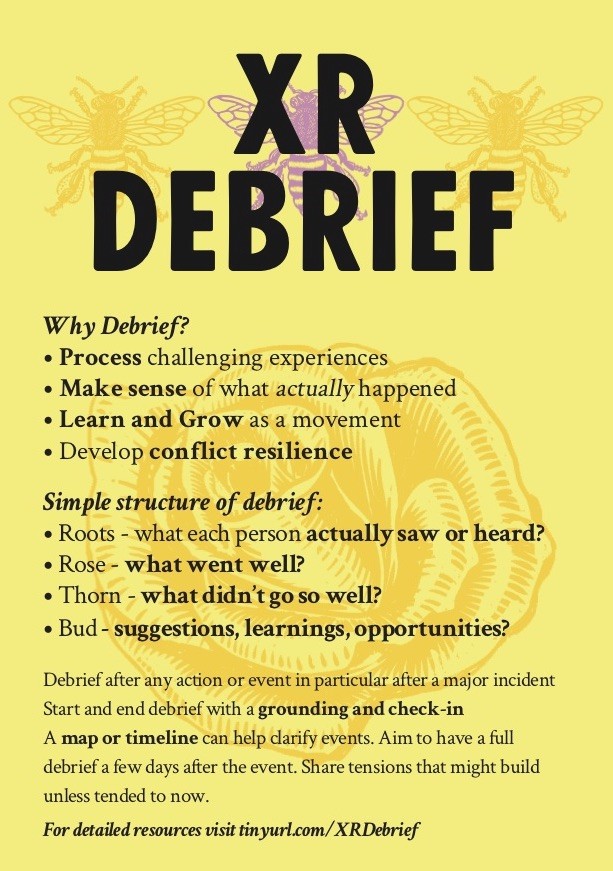How to debrief
As the movement grows, it is important that we learn from our achievements and our mistakes.
A debrief after an action gives us the opportunity to recognise our skills and weaknesses and to develop ourselves both as individuals and part of a team within the movement and our environment.
Although we are taking action for positive reasons, and often come away from these actions full of excitement, joy and energy, taking action can be emotionally heightening and stressful. It is likely that many people will have been running on adrenaline throughout the action. During moments of stress, our unconscious memory is more active. Debriefing can help process these memories and experiences.
After periods of heightened adrenaline, people may also experience a physical or emotional dip, which may leave them feeling unable to communicate, exhausted or experiencing negative thoughts. This is a completely normal bodily response but can feel destabilising and unpleasant in the moment. Debrief can offer a space to share and to get support in dealing with these feelings.
Hot debrief- immediately after the action
It’s a good idea to grab as many as possible from the team together to just check in with everyone, share how you’re feeling and share gratitude - regardless of how it went. If things went wrong, acknowledge that but don’t feel the need to resolve it there and then. You can cover it in more detail during the full debrief when everyone has had some reflection time.
Full debrief- a few days after the action
You may need to debrief different groups separately depending on the size of your action. And it may be appropriate to do these in a specific order to ensure that the feedback easily gets to the right people. For example, if planners debrief before any other groups you might miss some feedback.
If you are able to conduct the debrief in person that is ideal but often, it will need to be online.
The debrief facilitator doesn’t need to be a professional and shouldn’t be expected to magically fix anyone’s hurts. Rather, they should focus on moving the group through the different parts of the session, while taking part in the session themselves. If you are able to have someone that wasn't involved in the planning facilitate the debrief, this can be helpful to allow everyone to participate more fully and may allow any tensions to be managed better.
Note-taking during the debrief can further help the group to look back and see how much there is to celebrate or understand what can be learned for next time. It also gives people the opportunity to add to these if they are unable to attend or have more to add that they didn't share during the meeting. The learnings gathered from the debrief may also be useful to share with other circles and feed into your regional or national team.
Resources
Here are some resources to help you plan and structure debrief sessions. There are two main forms of debrief: our standard one and an emotional one. It is up to you which one fits best for your group and you may even want to do both.
- Simple Debrief - outline for 90 min session with 10 people & 2 facilitators
- Simple Emotional Debrief - outline for 90 min session with 4-8 people & 1 facilitator
- Emotional Debrief - for large groups modification for groups of more than 10 people
- Individual or Buddy debrief template
- Onsite debrief flyer
Note: This page has replaced the URL at the bottom of this image.

